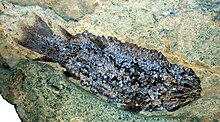Eusthenopteron
This article may be too technical for most readers to understand. (February 2018) |
| Eusthenopteron | |
|---|---|

| |
| Life restoration of Eusthenopteron foordi | |
| Scientific classification | |
| Domain: | Eukaryota |
| Kingdom: | Animalia |
| Phylum: | Chordata |
| Clade: | Sarcopterygii |
| Clade: | Tetrapodomorpha |
| Clade: | Eotetrapodiformes |
| Family: | †Tristichopteridae |
| Genus: | †Eusthenopteron Whiteaves, 1881 |
| Species[1] | |
| |
Eusthenopteron (from
The genus was first described by J. F. Whiteaves in 1881, as part of a large collection of fishes from Miguasha, Quebec, Canada.[4] Some 2,000 Eusthenopteron specimens have been collected from Miguasha, one of which was the object of intensely detailed study and several papers by paleoichthyologist Erik Jarvik between the 1940s and the 1990s.[5]
Description

Eusthenopteron is a medium- to large-sized
The earliest known fossilized evidence of bone marrow has been found in Eusthenopteron, which may be the origin of bone marrow in tetrapods.[7]
Eusthenopteron shares many unique features among fishes but in common with the earliest-known tetrapods. It shares a similar pattern of skull roofing bones with stem tetrapoda forms such as Ichthyostega and Acanthostega. Eusthenopteron, like other tetrapodomorph fishes, had internal nostrils (or a choana), one of the defining traits of tetrapodomorphs, including tetrapods. It also had labyrinthodont teeth, characterized by infolded enamel, which characterizes all of the earliest known tetrapods as well.
Unlike the early tetrapods, Eusthenopteron did not have larval gills.[8]
Classification


Like other fish-like sarcopterygians, Eusthenopteron possessed a two-part
Eusthenopteron differs significantly from some later
See also
References
- ^ S2CID 51883892.
- ^ Miller, S. A. (Samuel Almond) (1889). North American geology and palæontology for the use of amateurs, students, and scientists. Cincinnati, O. : [Western Methodist book concern]. p. 597. Retrieved 6 January 2022.
- ^ M. Laurin, F. J. Meunier, D. Germain, and M. Lemoine 2007. A microanatomical and histological study of the paired fin skeleton of the Devonian sarcopterygian Eusthenopteron foordi. Journal of Paleontology 81: 143–153.
- .
- ^ Geological Survey of Canada (7 February 2008). "Past lives: Chronicles of Canadian Paleontology: Eusthenopteron - the Prince of Miguasha". Archived from the original on 11 December 2004. Retrieved 10 February 2009.
- ^ a b Schultze, H.-P. 1984. Juvenile specimens of Eusthenopteron foordi Whiteaves, 1881 (Osteolepiform rhipidistian, Pisces) from the Late Devonian of Miguasha, Quebec, Canada. Journal of Vertebrate Paleontology 4: 1-16.
- ^ Amphibian evolution : the life of early land vertebrates (page 141)
- ^ M. Laurin, F. and J. Meunier 2012. A microanatomical and histological study of the fin long bones of the Devonian sarcopterygian Eusthenopteron foordi. Acta Zoologica 93: 88–97.
- ^ Zylberberg, L., Meunier, F. J. and Laurin, M. 2010. A microanatomical and histological study of the postcranial dermal skeleton in the Devonian sarcopterygian Eusthenopteron foordi. Acta Palaeontologica Polonica 55: 459–470.


